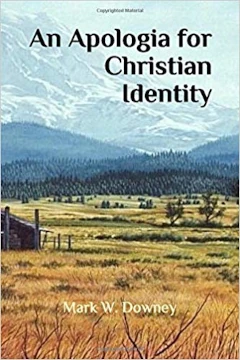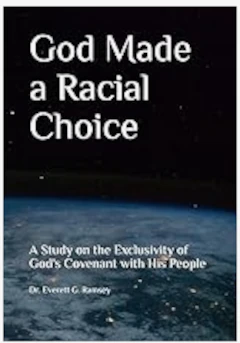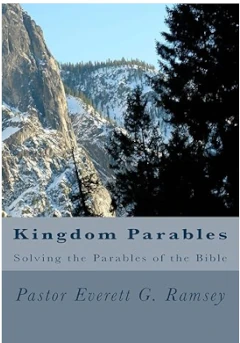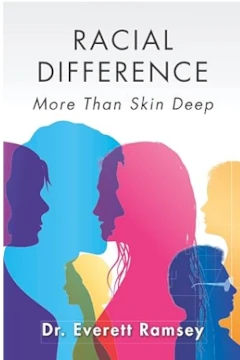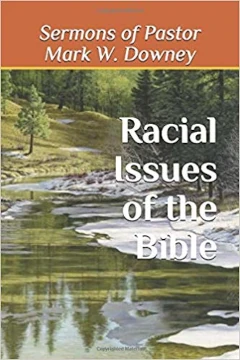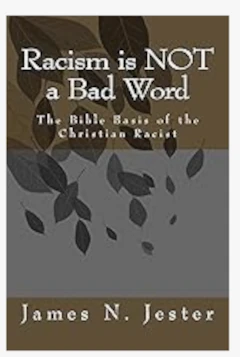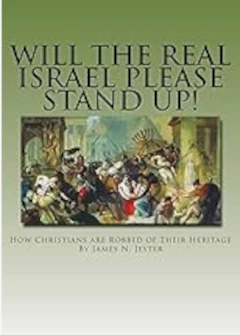R U Woke? Part 1
The First Two Chapters in Genesis
Sermon notes by Jim Jester
October 3, 2021
Scripture Reading: Psalm 8:1-6
“O LORD our Lord, how excellent is Thy name in all the earth! who hast set Thy glory above the heavens. 2 Out of the mouth of babes and sucklings hast Thou ordained strength because of Thine enemies, that Thou mightest still the enemy and the avenger. 3 When I consider Thy heavens, the work of Thy fingers, the moon and the stars, which Thou hast ordained; 4 What is man, that Thou art mindful of him and the son of man, that Thou visitest him? 5 For Thou hast made him a little lower than the angels, and hast crowned him with glory and honour. 6 Thou madest him to have dominion over the works of Thy hands; Thou hast put all things under his feet.” – Ps. 8:1-6
CRT and the anti-White Agenda
C. R. T. (Critical Race Theory) is a weapon designed to divide us and thus destroy the country. It teaches us to hate one another. Martin King said he wanted his children to be judged by the content of their character, not the color of their skin. C.R.T. is just the opposite – it judges a person’s character by the color of their skin, not the content of their character. Proponents of CRT believe that:
- Whites are innately racist
- The White mind is psychopathic
- Whites are irredeemable
- Whites must be discriminated against in order to have equity
Many in government and business have adopted this ideology, commonly called “Wokism;” and it is now being pushed into the schools to brainwash our children (Another good reason to get your kids out of government schools). Critical race theorists really are admitting that the “welfare” and “affirmative action” programs of the 1960’s was a complete failure, so now they must take a different route to achieve “racial equity.” In other words, “whiteness” is in their crosshairs. Are you “woke” yet?
Genesis
Genesis is a book of beginnings. Its title comes from the Greek word meaning “origins,” “birth,” or “existence.” We should note that if you drop the last letters “sis” you have the word “gene” or “genes” (if you drop “is”). Surely, everyone recognizes this word.
Genesis, the first book found in the Bible, is key to everything else contained in the Bible. All Christians regardless of their theological persuasion or personal beliefs should remember this principle. Not to understand this key book is to misunderstand the intent and meaning of the whole Bible.
The Book of Genesis is highly symbolic; therefore, the subject of creation should not be approached from a scientific perspective. We should not read these chapters as chronological, astronomical, geological, or biological statements, but as spiritual, moral, or racial concepts. The Book therefore, is the account of God’s Covenant Creation for it begins a new era with Adam’s insertion into a world of chaos.
The Expositor’s Bible has this comment [and I insert my own]:
“Indeed, if we were to bring these chapters into any comparison at all with science, we find at once various discrepancies. For example, a creation of sun, moon, and stars, after the creation of Earth, science would say, “Impossible!” Of the existence of fruit trees before the existence of the sun, science knows nothing. But for a candid reader without a special theory to maintain, details are needless. [but details will bring up questions]
Accepting this chapter then as it stands, and believing that only by looking at the Bible as it actually is, can we hope to understand God’s method of revealing Himself [and His children]… Intimate communion with God, a spirit trained to discern spiritual things, an understanding of, and zeal for, God’s purpose; these are qualities independent from the knowledge of science.” – Expositor’s Bible
So, if there are questions, we must deal with them. The key question concerning Genesis is, “Did all races come from Adam?” Upon this hinges all the concern about race and even if various races exist at all. Most of Christianity today believes all races came out of Adam and Eve. Thus, there is only one race – the “human race.” Therefore, there really is no such thing as other races. But is this true? And, what are the implications if it is not true?
As mentioned earlier, “race” is defined as “major divisions of humankind having distinct physical characteristics.” In the taxonomy of the plant and animal kingdoms, the word “specie” refers to specific characteristics of a living organism. This is obviously true because it is plainly observable. Therefore, race is real.
Further evidence that race is real is found in the Bible’s genealogical records. If race does not exist, then why is the Word of God so concerned about genetics? The fact that the Bible clearly traces families and genetic lines proves that race is of important significance.
Finally, the meanings and the uses of words in the Bible and other ancient texts prove that race is real. For instance, repeatedly, in the Septuagint (Greek Old Testament), the word “allogenes” (allos = another, genos = race) is used to show prohibitions regarding certain “strangers” and other cases. Properly interpreted, this word means “of another race.” To deny that races exist is to reject the meaning and intent of the Greek. This word, allogenes, should be remembered as great ammunition (a “silver bullet”) against those who come against us saying, “there is no race, only the human race” for it proves them wrong.
Judeo-Christians say their beliefs come from the Bible, yet when it comes to race they have no credible theory for the creation of the races. Genesis chapter one clearly teaches that God’s creation reproduces “after their kind.” To teach, as “Answers in Genesis”, that all the various races came from one couple, is in reality teaching evolution – the very thing they say they oppose.
Trinity?
Let us delve into several passages from the book of Genesis, starting with Genesis 1:26; “…Let us make man….” You may notice it is in the first person plural. Since we know God as being One, and not multiple Gods, the most common explanation is a reference to the Trinity of Father, Son, and Holy Spirit. But is this really true and valid as a doctrine? I suppose we would have to define what is meant by the term “Trinity.” But, let us look at some of the explanations.
First, the common Christian view in the words of Chuck Smith:
Now you have God saying “let us make man in our image after our likeness.” Who was God talking to? God, after the counsel of His own will, in the triunity of the Godhead which we, in our feeble, finite minds cannot comprehend. But in that trinity of His nature, He said “let us make man after our image” and thus He made man after His image, a trinity of nature. So God is a superior trinity. Man, made in the image of God is an inferior trinity. The superior trinity being Father, Son and Holy Spirit, the inferior trinity of man being body, soul and spirit. – Chuck Smith
And there are Scriptures that seem to support such a doctrine:
“In the beginning was the Word, and the Word was with God, and the Word was God. 2 The same was in the beginning with God. 3 All things were made by Him; and without Him was not anything made that was made.” – Jn. 1:1-3
“For there are three that bear record [in heaven, the Father, the Word, and the Holy Ghost: and these three are one. 8 And there are three that bear witness in earth], the Spirit, and the water, and the blood: and these three agree in one.” – I Jn. 5:7-8
However, there is a problem here. The words in gray are not in the early Greek manuscripts. Therefore, this Scripture is not dependable enough to prove a Trinity. There may have been an alteration by someone. Therefore, this passage should be translated thusly (as many are):
“And the Spirit is the witness, because the Spirit is true. 8 There are three witnesses, the Spirit, the water, and the blood: and all three are in agreement.” – I Jn. 5:7-8, BBE
Furthermore (and we still have a problem), this verse is not speaking of a triune Godhead, unless one considers “water” and “blood” the Father and the Son (respectively). In addition, the previous passage from the Gospel of John does not prove a Trinity, only the unity of Father and Son.
In spite of this, most of the Reformers believed in the concept of the Trinity, such as is expressed in the words of John Wesley:
Man’s creation was a signal act of divine wisdom and power, beyond that of the other creatures. The narrative of it is introduced with solemnity and a manifest distinction from the rest. Hitherto it had been said, “Let there be light,” and “Let there be a firmament:” but now the word of command is turned into a word of consultation, “Let us make man” – For whose sake the rest of the creatures were made. Man was to be a creature different from all that had been hitherto made. Flesh and spirit, heaven and earth must be put together in him, and he must be allied to both worlds. And therefore, God himself not only undertakes to make, but is pleased so to express himself, as if He called a council to consider of the making of him. “Let us make man” – the three persons of the Trinity, Father, Son, and Holy Ghost, consult about it, and concur in it; because man, when he was made, was to be dedicated and devoted to Father, Son, and Holy Ghost. That man was made in God’s image, and after his likeness; two words to express the same thing. – Wesley
There is profound truth here about our relationship to our Creator. But, this is not a definition of the Trinity; perhaps we should simply say that it expresses the unity of the three manifestations of God. “Hear, O Israel: The LORD our God is one LORD” (Deut. 6:4). This “One Lord” is literally our Father; the Son is the physical manifestation of the Father, who came to be our Redeemer; and the Spirit is the comfort, inspiration, strength and mind of God our Father. This is something that those of all Christian persuasions and doctrines can agree with.
The Alpha Omega Bible translates Genesis 1:26 thusly (in all Caps like the Hebrew) and then adds a note.
Gen. 1:27 (Vs. 26) THEN THE THEOS (Alpha & Omega) SAID, “LET US MAKE MAN IN OUR LIKENESS, ACCORDING TO OUR LIKENESS; AND LET THEM RULE OVER THE FISH OF THE SEA AND OVER THE BIRDS OF THE SKY AND OVER THE CATTLE AND OVER ALL THE EARTH, AND OVER EVERY CREEPING THING THAT CREEPS ON THE EARTH.” †(The use of the words “US & OUR” does not automatically induce that there must be more than one member of The THEOS head. It was common for Kings of Empires to say phrases like “We proclaim, We declare” to signify their power, strength and majesty. “US & OUR” is being used here as a plural of power, strength and majesty. Not as a plural of persons or heads. In the ancient Paleo-Hebrew, Assyrian Aramaic & Greek languages, the verbs also played a part in signifying whether the noun or subject was singular or plural. The verb “MAKE” in this verse is singular, which could only be possible if the subjects “US & OUR” are also singular. The context of the previous and following verses also signify that THEOS is singular, not plural. The Assyrian word “Elohim” can be either singular or plural, see Ex. 7:1 & Ex. 32:4. The Greek Septuagint used the word “THEOS” which is a singular word. All evidence is that THEOS is a single Being, one Spirit, not three. Theos is singular in chapter 1, verse 1, as well as in all verses which use the word “Theos”.)
This explanation seems to simplify the issue on the “Trinity” and is quite simple and conclusive. So much for the plural meaning of “us.”
The only other verses we could possibly use to support a Trinity doctrine might be:
Matthew 28:19, “Go ye therefore, and teach all nations, baptizing them in the name of the Father, and of the Son, and of the Holy Ghost.”
II Corinthians 13:14, “The grace of the Lord Jesus Christ, and the love of God, and the communion of the Holy Ghost, be with you all. Amen.”
Regarding Matthew’s account, Mark and Luke do not concur. Neither of them makes any use of the three “Godheads,” which we would expect if it were important enough to be dogma. Regarding the closing of Paul’s letter to the Corinthians, it expresses the blessings of the Christian life: grace, love, and communion of the saints, not a proof of dogma, especially since it would be the only verse in the New Testament to support it. We cannot claim a particular doctrine based on just one verse. There must be more than one witness to establish a truth.
Gap Theory
There is a theory (sometimes called the “Gap Theory”) that between verses one and two of Genesis there was a very long age when the Earth was inhabited by a very primitive creation.
“And the earth was without form, and void; and darkness was upon the face of the deep.” – Gen. 1:2
The word “was” is a state of “being” or “existence.” Here it is the Hebrew word “hayah.” Albert Barnes says of this passage:
היה hāyah, “be. ” It is to be noted, however, that the word has three meanings, two of which now scarcely belong to our English “be. ”
1. “Be,” as an event, start into being, begin to be, come to pass.” This may be understood of a thing beginning to be.
2. “Be,” as a change of state, “become.” This is applied to what had a previous existence, but undergoes some change in its properties or relations; “and she became” a pillar of salt, Gen. 19:26.
3. “Be,” as a state. This is the ultimate meaning to which the verb tends in all languages. In all its meanings, especially in the first and second, the Hebrew speaker presumes an onlooker, to whom the object in question appears coming into being, becoming or being, as the case may be. Hence, it means to be manifestly, so that eye-witnesses may observe the signs of existence. – Barnes
Verse two begs the question, if God created the world in verse one, then what happened for the Earth to be in such a terrible state in verse two? Certainly, God would not have created it in such a useless and void condition, would He?
E. W. Bullinger had this to say about the verse:
The Earth, “was” = became. See Gen. 2:7; 4:3; 9:15; 19:26. Ex. 32:1. Deut. 27:9. II Sam. 7:24. Also rendered came to pass Gen. 4:14; 22:1; 23:1; 27:1. Josh. 4:1; 5:1. I Ki. 13:32. Isa. 14:24. Also rendered be (in the sense of become) Gen. 1:3, and where the verb “to be” is not in italic type. Hence, Ex. 3:1, kept = became keeper, quit = become men.
“without form” = waste. Hebrew, tohu va bohu. Figure of speech, Paronomasia. Not created tohu (Isa. 45:18), but became tohu (Gen. 1:2; II Pet. 3:5-6). “An enemy hath done this” (Matt. 13:25, 28, 39. Compare I Cor. 14:33.) – Bullinger
It would not make sense for God to create something that is useless, and He even says so in Scripture, “For thus saith the LORD that created the heavens … he hath established it, he created it not in vain, he formed it to be inhabited: I am the LORD; and there is none else” (Isa. 45:18).
The prophet Jeremiah looked at the earth and saw it formless and void, the same words used in Genesis 1:2,
“I beheld the earth, and, lo, it was without form, and void; and the heavens, and they had no light. 24 I beheld the mountains, and, lo, they trembled, and all the hills moved lightly. 25 I beheld, and, lo, there was no man, and all the birds of the heavens were fled. 26 I beheld, and, lo, the fruitful place was a wilderness, and all the cities thereof were broken down at the presence of the LORD, and by his fierce anger.” – Jer. 4:23-26
According to Jeremiah, this condition existed after the fruitful land became a wilderness, and after all the cities were pulled down. What cities, and who lived in those cities? Could Atlantis have been one; could the cities have been the places of the Nephilim (giants)? This would certainly lead one to believe that between the first two verses in Genesis, there had been an age of ancient civilization. This theory is also supported by the fact that science has found abundant evidence of life that predates Adam by hundreds of thousands of years. The theory goes on to say that this ancient world is the one over which Satan ruled, and it became so totally corrupt that God destroyed it. This is the “formless and void” condition we find in Genesis 1:2 and to which Jeremiah referred. Surely, this theory allows for the great antiquity necessary for some of the findings of science.
Therefore, we have at least two Scriptural witnesses, and there are others, giving credit to this theory of an unspecified, pre-Adamic, period. Even though Genesis does not suggest a primitive civilization, by taking the whole of Scripture we find evidence that there was a primitive state in Genesis. And thus, chapter one is not the original creation, rather, it is a re-creation or renovation; and one by which brother Blanchard has termed “God’s covenant creation.”
Scientists agree and tell us the Earth is very old, not as some Christians say that the Earth is young, only six to seven thousand years of age. This young age presupposition is only the age of biblical history. When modern theologians make the Earth young, it is because they are attempting to make the creation of man appear universal in nature; thus, as Answers in Genesis says, “all races have come from Adam.” And, “God made all the races and loves them equally.” This is a false assumption.
Other “Men”
One question that has been argued for centuries is whether there were human beings on Earth before the time of Adam and contemporary with him. In this argument there seems to be evidence in the Scriptures supporting pre-Adamic humans. In a book by Conrad Gaard entitled, Was Adam the First Man?, the author pursues the meaning of Hebrew words. He argues that the Hebrew term “Chai Nephesh” translated “living soul” in Genesis 2:7 is identical to the term as that which is rendered “living creature” in Genesis 1:21. Here are the two passages:
Gen. 2:7, “And the LORD God formed man of the dust of the ground, and breathed into his nostrils the breath of life; and man became a living soul.”
Gen. 1:21, “And God created great whales, and every living creature that moveth, which the waters brought forth abundantly, after their kind, and every winged fowl after his kind: and God saw that it was good.”
In the first quotation, the “living soul” is the man Adam whom God then (v. 8) placed in the Garden of Eden. In the second quotation, the “living creature” could also be man, since the very same term is used here as for the man in Gen. 2:7. Although this is not proof of an earlier man, the possibility exists. Note that the latter reference takes place on the 5th day of creation.
Gaard then refers to Job 26:5, which, as rendered in many translations, does not make sense. In the authorized KJV it reads, “Dead things are formed from under the waters, and the inhabitants thereof.” Gaard insists that the “dead things” or “departed spirits” should read “Rephaim,” the Hebrew word translated “dead.” Gaard says,
“We know that the Scriptures tell us of a race of giants called the Rephaim, over whom Og reigned as king, and it seems quite evident that Job is merely saying that these Rephaim, or giants, were formed together with the inhabitants of the waters. In short, they must have been among the Living creatures (Chai Nephesh), which the waters brought forth abundantly, after their kind, during the fifth creative day, and it seems quite certain that at least one race of human beings was created before Adam.” – Conrad Gaard, Studies in Genesis, p. 3
The Brenton Septuagint translates Job 26:5 in the form of a rhetorical question, which fits the context in the book of Job; “Shall giants be born from under the water and the inhabitants thereof?”
Not only the “Rephaim” in Job and elsewhere are called “giants”; but Genesis 6:4 also refers to giants, the Hebrew word here being “Nephilim.” Altogether, there are seven different Hebrew words rendered “giants.”
Second Account Theory
Let us go back to our text in Genesis 1:27, “So God created man in his own image…”. This verse is within the period of the 6th day of creation. It has been argued that the “created man” in this verse is a previous creation to the man God formed from the “dust of the ground” in Genesis 2:7. This we agree upon. Most theologians believe it is a “second account” of the creation of the same man (Adam), only more detailed. If it is, then why? What purpose would be manifested? This explanation of a Second Account has many more problems than the belief that Genesis 2:7 begins a new era in God’s timetable. The opponents of the Second Account theory (such as Christian Identity) believe that the man formed in 2:7, into whose nostrils God breathed the breath of life, was Adam, the very son of God. Being the son of God, he received the living Spirit of God, as 2:7 says, “man became a living soul.” This position has support from Luke’s genealogy, “Which was the son of Enos, which was the son of Seth, which was the son of Adam, which was the son of God” (Lk. 3:38). Jesus the Christ is called the Son of God, and He is referred to by Paul as the Second Adam:
I Cor. 15:45, “And so it is said, The first man Adam was a living soul. The last[or second] Adam is a life-giving spirit.”
I Cor. 15:47, “The first man is from the earth, and of the earth: the second man is from heaven.”
The belief that Adam was distinct from, and subsequent to, the man created in 1:27 also provides a people to whom Cain goes and takes a wife in Genesis 4:16-17.
Another real problem with the Second Account theory is that God said His work was finished:
“Thus the heavens and the earth were finished, and all the host of them. And on the seventh day God ended his work which he had made; and he rested on the seventh day from all his work which he had made.” – Gen. 2:1-2
Then it states quite emphatically, “These are the generations of the heavens and of the earth when they were created, in the day that the LORD God made the earth and the heavens…” (Gen. 2:4). This seems to be a rather final statement and in no way suggests that a rehash would be coming. Furthermore, the word “created” is not used again in the rest of the chapter or the book of Genesis.
Another difficult problem facing the Second Account theorists is that in chapter one God said, “…male and female He created them.” In the case of Adam, there is no mention of a woman until after God put him in the Garden of Eden and gave him instructions.
While fundamentalist Christianity rightfully takes a stand against the theory of evolution, what they fail to grasp is; in accepting the Second Account of the same man (Adam) theory, they must also submit to evolution. This must be so in order to get the different races of “men” (more accurately, “human”) out of Adam. They must believe that Adam is the father of all humankind. The establishment has built an entire superstructure on this theory. But, this theory must come down just as the tower of Babel came down; and as modern Babylon must also come down. Those who support the Second Account theory are not motivated by good Bible exegesis, but by the plagues of humanism that have infested their Christian doctrines for many years. They have felt they must defend their doctrines or their entire system will collapse. And indeed, it needs to collapse to become racially aware (R U woke?).
Christian Identity proposes that Genesis 2:7 is not 1:27 described, but that 2:7 is a spectacularly different act than 1:27, that 2:7 is in addition to, and subsequent to, 1:27; and that all Bible history is based upon 2:7. So, the “Second Account” (of the same man) does not actually exist because the two men are different creations. The so-called “second account” should be called “another account.”
Study of Man
In the study of “man” in Genesis chapters 1 and 2, it is interesting that the Hebrew word for man and for Adam is the same word. The question then arises why Bible translators use the word “man” in some places and the word “Adam” in others. For example, the King James Version introduces the name “Adam” in 2:19, but the New American Standard Bible introduces the name in 2:20. Of the many translations, this anomaly occurs split about half the time. There is not a clear distinction in the use of the terms in these chapters. The conclusion must be that the translation of Hebrew to English is not always clearly made. The English language is not capable of expressing all Hebrew meanings; therefore, the gap between the languages is not always bridged easily, consistently or accurately. This is likely the case with the word “man” in Gen. 1 & 2.
It is not until we get to Genesis 2:23 that a different Hebrew word for “man” is used. It is the Hebrew word iysh, or ish (as in British), which frequently is not expressed in translation. If it is not expressed, then we have missed the true Hebrew meaning. The meaning of this Hebrew word carries the sense of distinction, of high degree, good, husband. This is the man from whom God made the woman in 2:23. This distinction of character will be seen throughout the Scripture.
The book of Job is the oldest writing in the Bible. In this book, the word “man” is used 93 times; so it has much to say about mankind. Strong’s Concordance shows that four Hebrew words are translated “man” in English. They are: 1) adam 2) ish 3) enosh 4) gabar. One need not be a Hebrew scholar to suspect that each term has a significant meaning. Adam means “ruddy, to show blood in the face, flush or turn rosy, man of low degree.” Ish is defined as “man of high degree, worthy.” Enosh is “mortal (and thus differing from the more dignified Adam).” Gabar means “valiant man or warrior, mighty, be stronger, prevail.”
Some examples to illustrate their use from Job and Psalms (BBE):
Job 1:1 “There was a man [ish] in the land of Uz whose name was Job. He was without sin and upright, fearing God and keeping himself far from evil.”
Job 1:3 “…And the man [ish] was greater than any of the sons of the east.”
Job 10:4-5 “Have you eyes of flesh, or do you see as man [enosh] sees? Are your days as the days of [mortal] man [enosh], or your years like his?”
Job 25:4 “How then is it possible for man [enosh] to be upright before God?
Psalm 8:4-5 “What is man [enosh], that you keep him in mind, or the son of man [adam], that you take him into account? For you have made him [adam] only a little lower than the gods, crowning him with glory and honor.”
Psalm 9:19-20 “Up! O Lord, let not man [enosh] overcome you: let the nations be judged before you. Put them in fear, O Lord, so that the nations may see that they are only men [enosh].”
After Job and Psalms, only Isaiah uses the term “enosh.” After that, it is no longer used in the Old Testament (if Strong’s is correct). One cannot correctly read Job and Psalms without a proper understanding of “ish” and “enosh.” Without this distinction and labeling them all as “men,” these books become confusing and contradictory. The English term “man” tends to impress upon the reader a universal and humanistic flavor to the Scriptures. When modern readers see the word “man” they do not question the kind of man it is, they just assume it means all men.
Some of these terms may very well represent other races of men; if so, then the idea that “all races are equal” is foreign to the ancient world. Even people of the same race have differences in their abilities. In the American Declaration the words “created equal” should be dropped so that the statement would therefore read: “We hold these truths to be self-evident, that all men are endowed by their Creator with certain unalienable Rights, that among these are Life, Liberty and the pursuit of Happiness.” From the study of Hebrew words (or any of the ancient languages) it is obvious that all “men” are not equal.
Conclusion
There are all kinds of men in the world with various degrees of character flaws and outright sins. Does anyone consider that this condition could be based upon genetics? Not many blame breeding today, but rather, they usually blame family conditions and environment, which often does have drastic effects upon the character of a person.
With all kinds of “men” (this includes races and ethnic mixes) in the world, why would a nation allow its borders to be open? What is happening at our southern border is madness. Only our enemies would allow such mass immigration (invasion) to eventually out-vote and out-breed the white man. Does not the white race have the right to life, liberty, and the pursuit of happiness? Why can’t judeo-Christians see the foolishness and futility of allowing everybody into the country to supposedly “convert” them? It must be that they are “judeo” (at least in belief, if not in genetics).
You may have noticed that one of the above verses was part of our Scripture reading: “What is man [enosh, i.e., mortal man], that Thou art mindful of him and the son of man [adam], that Thou visitest [i.e., came and redeemed] him? 5 For Thou hast made him [adam, i.e., a man of low degree] a little lower than the angels, and hast crowned him with glory and honour [majesty, dominion]” (Ps. 8:4-5). We are destined for the kingdom of God. We are God’s covenant creation! What an awesome thought! And therefore, it is God who lifts us up; we cannot lift ourselves: “For every one that exalteth himself shall be humbled; and he that humbleth himself shall be exalted” (Lk. 14:11, ASV).



